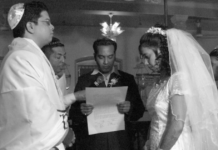
In 2009, Toronto’s Indian-Jewish community commemorated the 30th anniversary of Congregation BINA (Bene Israel North America), the city’s first and only Indian-Jewish prayer congregation. It was founded in 1979 by 35 to 50 Indian-Jewish families and presently comprises 250 to 300 members, mostly from Toronto but also from Kingston, Hamilton, Montreal, and New York. BINA provides services to members of all three Indian-Jewish communities: Bene Israel, Cochin Jews, and Baghdadi Jews, all of whom were born in Iraq and immigrated to British-ruled India in the eighteenth century. The leadership of Indian-Jewish immigrants has now transferred to their Canadian-born progeny. BINA was founded in response to the exclusion by the Ashkenazi (2)-dominated Toronto Jewish community and its members, and it continues to function.
Nonwhite immigrants were allowed to settle in Canada after changes to Canadian immigration policy were made in 1962. During the 1960s and 1970s, Canada became a popular destination for English-speaking, highly educated, and professional Indian Jews, since the Canadian economy was in desperate need of skilled and professional workers. Between 1964 and 1980, the first wave of Indian-Jewish immigrants arrived in Toronto, quickly establishing socioeconomic stability. Soon after, Indian Jews attempted to join their Jewish coreligionists by joining Toronto’s Jewish community, but they were met with hostility by Canadian Jews who questioned Indian Jews’ Jewish status. According to Toronto’s Indian Jews, their Ashkenazi co-religionists (3), who are deemed white ethnic “others” in Canada, have been reluctant to understand that one might be both South Asian and Jewish. These racialized identities are held in binary opposition by the Ashkenazi majority: Jews are white and of European heritage; Indians are Hindu or Muslim. When Indian Jews dress in traditional Indian garb, prepare and consume kosher versions of Indian dishes, and converse in Indian languages, Ashkenazi Jews become even more perplexed. Diverse Jewish identities and realities that reflect distinct social, historical, geographic, economic, and cultural settings are excluded by homogeneous and essentialist claims of a “genuine” Jewish identity.




